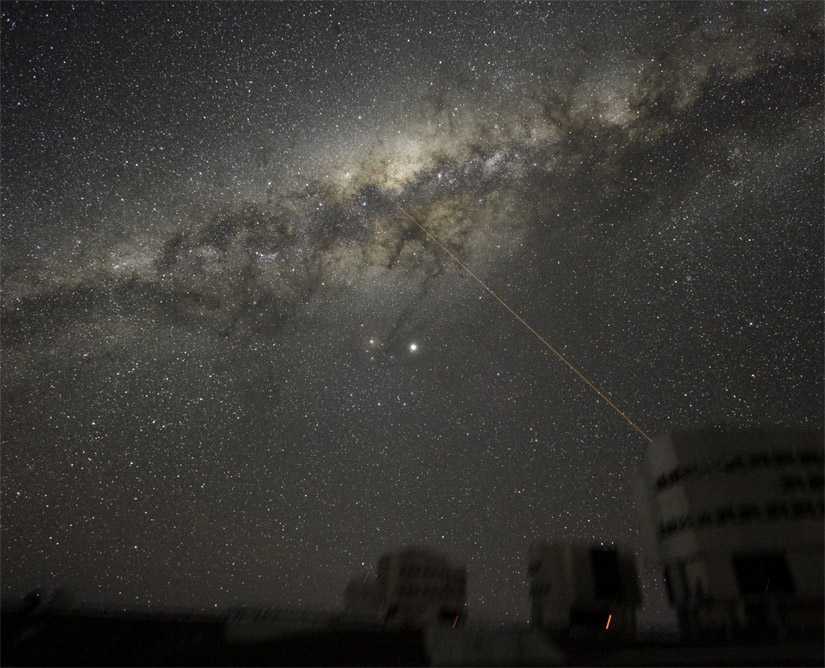Dark Matter Exposed? Gamma-Ray Find Excites Scientists

Energetic light seen radiating from the center of the Milky Way may be the best evidence yet of dark matter, the invisible stuff thought to be hiding throughout the universe.
A new study has found a strong signal of gamma-rays — light of a very short wavelength — coming from the middle of our galaxy, which may be the result of exploding dark matter.
Scientists think dark matter, which seemingly makes up the majority of matter in the universe, is made of particles called WIMPs ("weakly interacting massive particles"). And WIMPs, when they get very close to other WIMPs, should annihilate each other, because these particles are thought to be their own antiparticles. (When particles of matter and their antimatter counterparts meet, they destroy each other.)
In the dense center of the Milky Way, enough WIMPs should exist that many bump into each other, exploding into pure energy that gives rise to other particles and, eventually, gamma-rays.
An abundance of gamma-rays is exactly what scientists see when looking toward the center of our galaxy with the Fermi Gamma-Ray Space Telescope. In the new study, researchers found a definitive signal of gamma-rays that couldn't be traced to any known object in this region. [No WIMPS in Space? - NASA Scans For Dark Matter | Video]
'Something new'
"It's definitely something new and shining in the gamma-ray there, and it's not attributable to the existing sources in the catalog," said University of California, Irvine astrophysicist Kevork Abazajian, co-author of a paper reporting the findings submitted to the journal Physical Review D.
Breaking space news, the latest updates on rocket launches, skywatching events and more!
Abazajian, with his UC Irvine colleague Manoj Kaplinghat, searched for this light using Fermi data taken between 2008 and 2012. Previous studies by Dan Hooper, a scientist at the Fermi National Accelerator Laboratory (Fermilab) and the University of Chicago, also found evidence for this gamma-ray radiation, but other follow-up searches came up empty.
Abazajian said his study used the most complete data set yet and analyzed it with a comprehensive analysis specially tuned for investigating gamma-ray light in a crowded region.
"Definitely, definitely, there is a source," Abazajian told SPACE.com. "This is definitely not just a fluctuation."
However, whether this source was created by annihilating dark matter particles is somewhat less certain. It's also possible, Abazajian said, that a large group of dense, spinning stars called pulsars could be releasing the light.
However, he said, three characteristics of the detected gamma-ray radiation — its rate of emission, the variety of particular wavelengths of the light (its spectrum), and the overall shape of the emission — are all consistent with predictions for dark matter annihilation.
"I think it could be a very big finding," Abazajian said. "When I came across this, I was like, 'Holy cow, this is so consistent with the dark matter interpretation in many ways.' But until you can rule out the astrophysical potential sources for something similar, it's not going to be a smoking gun."
Ruling out alternatives
Fermilab's Hooper, for his part, is even more confident that scientists finally are seeing the elusive signature of dark matter.
"If you make a comparison to what they found and what we've been talking about — we're looking at the same source," Hooper said. "I still think dark mater annihilation is the easiest way to explain the signal. I think the signal is too spatially concentrated to be coming from pulsars."
Hooper acknowledged that many astrophysicists are skeptical. "There's vigorous debate going on about the astrophysical alternatives to explain this signal," he said. "I'm of the opinion that those are difficult to make work."
Many experts are waiting for scientists in the official Fermi telescope collaboration to weigh in with their own analysis of the radiation at the center of the galaxy.
"We will have results to report of this soon," said UC Irvine astrophysicist Simona Murgia, a member of the Fermi collaboration galactic center analysis team.
Murgia praised the study by Abazajian and Kaplinghat. "This is good work and the authors have considered a number of plausible interpretations" for the data, she wrote in an email.
"I can only emphasize that it is very difficult to disentangle all the different contributions to the observed data in this region of the sky, and I think more work needs to be done to make a definitive statement," she added.
Dwarf galaxies
For confirmation that dark matter has really been found at the center of the Milky Way, scientists may have to look outside the galaxy to the small dwarf galaxies orbiting it.
Theory predicts that WIMPs, if they exist, should be annihilating each other in the centers of those satellites, too. If the same type of gamma-ray emission can be observed in these galaxies, dark matter would be strongly implicated, Abazajian said. However, studies of such dwarf galaxies have so far turned up essentially no gamma-rays.
"The real smoking gun to show if this is dark matter annihilation or not is to look deeply at these low background sources and see if you see this signal or not," he said. "If you were able to see the same rate, spectrum or morphology in several sources, that would be a real abundance of evidence."
Follow Clara Moskowitz on Twitter @ClaraMoskowitz or SPACE.com @Spacedotcom. We're also on Facebook & Google+.

Clara Moskowitz is a science and space writer who joined the Space.com team in 2008 and served as Assistant Managing Editor from 2011 to 2013. Clara has a bachelor's degree in astronomy and physics from Wesleyan University, and a graduate certificate in science writing from the University of California, Santa Cruz. She covers everything from astronomy to human spaceflight and once aced a NASTAR suborbital spaceflight training program for space missions. Clara is currently Associate Editor of Scientific American. To see her latest project is, follow Clara on Twitter.
